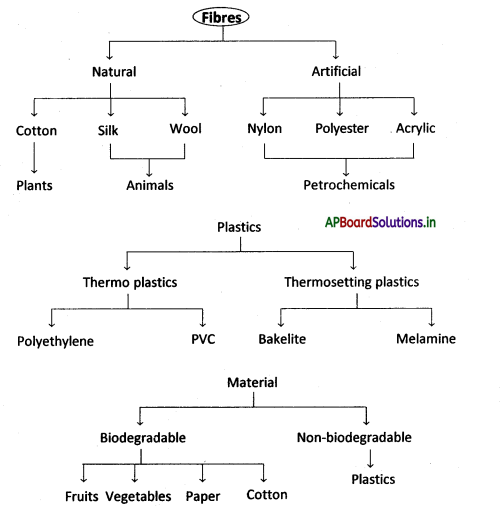Students can go through AP State Board 8th Class Physical Science Notes Chapter 4 Synthetic Fibres and Plastics to understand and remember the concept easily.
AP State Board Syllabus 8th Class Physical Science Notes Chapter 4 Synthetic Fibres and Plastics
→ Synthetic fibres and plastics are made of large units called polymers.
→ Polymers are made up of many smaller units.
→ Natural fibres are obtained from plants and animals.
→ Artificial fibres are obtained by chemical processing by petrochemicals.
→ Synthetic fibres find uses ranging from many household articles like ropes, buckets, furniture, containers.
→ Depending upon the type of chemicals used for manufacture there are different synthetic fibres.
→ Commonly used synthetic fibres are rayon, nylon, polyester and acrylic.
→ Rayon is artificial silk made of cellulose fibre.
→ Nylon is made artificially by using raw materials like coal, water and air.
→ Polyester is a synthetic fibre.
→ Acrylic is artificial wool made from coal, air, water, oil and limestone.
→ The different types of fibres differ from one another in their strength, water-absorbing capacity, nature of burning, cost and durability.
→ Synthetic fibres and plastics enveloped our life.
→ The waste created by plastics is not environmentally friendly.
→ On burning plastics release poisonous gases.
→ Plastics take years to decompose. This is because of their non – biodegradable nature.
![]()
→ Enjoy the good qualities of synthetic fibres and plastics and reduce the indis¬criminate use of plastics to minimize environmental hazards.
→ Synthetic fibres find uses ranging from household articles to healthcare.
→ Synthetic fibres blend with natural and artificial fibres
→ Acrylic: Acrylic ¡s artificial wool made from coal, air, water, oil and limestone.
→ Synthetic fibre: Artificiàl fibres are also called synthetic fibre.
→ Bakelite: Bakelite is a thermosetting plastic that is a poor conductor of heat and electricity so ¡t is used for making handles of various utensils.
→ Biodegradable: A material which is easily decomposed by natural processes ¡s called biodegradable.
→ Blend: Any synthetic can be combined with two or more other fibres ¡s called blend.
→ Acrylic: Acrylic is artificial wool made from coal, air, water, oil and limestone.
→ Synthetic fibre: Artificial fibres are also called synthetic fibre.
→ Bakelite: Bakelite is a thermosetting plastic that is a poor conductor of heat and electricity so ¡t is used for making handles óf various utensils.
→ Biodegradable: A material that is easily decomposed by natural processes is called biodegradable.
→ Blend: Any synthetic can be combined with Iwo or more other fibres is called blend.
→ Cellulose: The source material obtained from wood pulp is called cellulose.
→ Incinerators: The instruments used for burning plastic.
![]()
→ Melamine: It is a thermosetting plastic used for making utensils and groceries.
→ Natural fibres: The fibres which aré made from plants and animals.
→ Non-biodegradable: A material that is not decomposed by natural processes is called non-biodegradable material.
→ Nylon: The polymer is made of chemical units called polyamides
→ Petrochemicals: The chemiçals obtained from petroleum are called petrochemicals.
→ Plastics: Plastics are polymers having linear chains or cross-linked chains.
→ Polymer: Many small, identical units combine to form a large unit called a polymer.
→ Polyamide: Polyamides are polymers made with monomers like hexamethylene diamine and adipic acid.
→ Polythene: Polymer made of small monomers called ethene.
→ Polyester: Polyester is a polymer formed by reacting dicarboxylic acid with a dihydric alcohol
→ Rayon: The artificial fibre obtained from wood pulp
→ Recycling: Recycling is a process to convert broken plastic material into new plastic products
→ Spinneret:‘ Metal ploteš with’ very very tiny holes.
→ Terracotta: The artificial fibre obtained from polymer to make a cloth It s a mixture of terylene and cotton
→ Terylene: The artificial fibre obtained from polymer to make a cloth. Terylene ¡s most popular polyester.
→ Terriwool: Terriwool is an artificial fibre made from polymer It is a mixture of terylene and wool
→ TerriThermoplostcs ‘b”: The plastics which will be deformed easily on heating and can be bent
![]()
→ Thermosetting plastic: The plastics which moulded once can’t be softened by heating are called thermosetting plastics.
→ Universal recycling symbol: In a recycling icon if the number that identifies the polymer is omitted then the symbol is called the universal recycling symbol
→ Artificial fibre: The fibre obtained artificially from petrochemicals are called artificial fibres.
→ Silkworm: The insect which produces silk

→ Eugen Baumann (1846 – 1896):
- Polyvinyl chloride was first created by Eugen Baumann.
- He identified the source for aromatic compounds in urine being the aromatic amino acids such as tyrosine.
- He influenced organ o sulphur chemistry by the synthesis